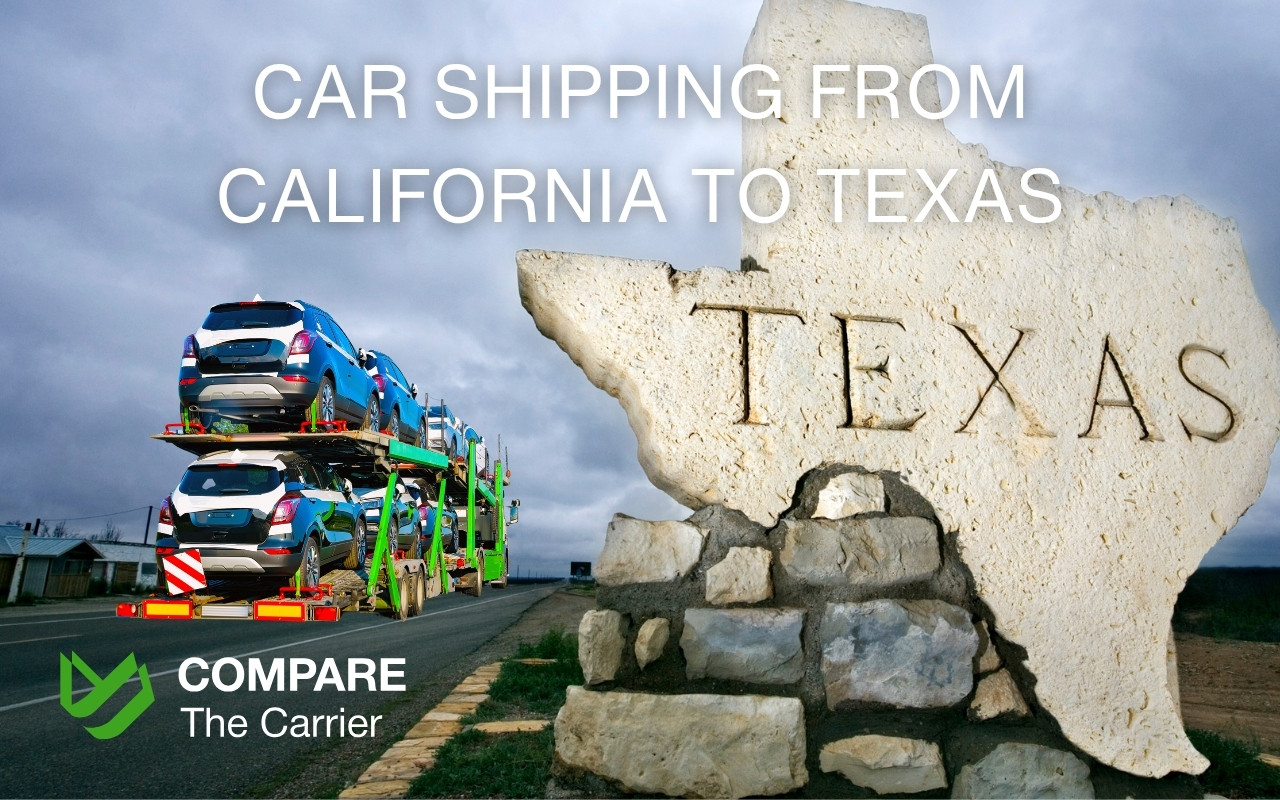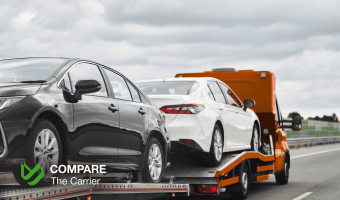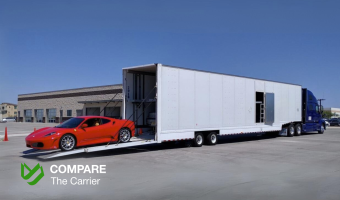Why Ship a Car from California to Texas?
Over 365,000 Californians moved to Texas in the past five years, according to 2024 U.S. Census Bureau migration data1. Whether it’s for a new job in Dallas, retiring near Austin, attending college in Houston, or relocating your dealership inventory, California to Texas vehicle transport is in higher demand than ever.
That demand isn’t just about convenience—it’s also about strategy. Driving over 1,500 miles across state lines can rack up thousands in fuel, lodging, and wear and tear. And if you’re moving a luxury vehicle, a classic, or multiple autos? The risks multiply. That’s why more people are turning to auto transport professionals for safe, cost-effective delivery from California to Texas.
Using a trusted auto transporter through a vetted platform like CompareTheCarrier.com ensures you’re not just getting from CA to TX—you’re getting there with peace of mind, transparent pricing, and expert-backed service.
Let’s break down how it all works — from selecting a transporter to delivery at your new doorstep in Texas.
How Auto Transport Works from California to Texas
Shipping a car from California to Texas may sound complicated, but the process is actually streamlined—especially when you work with licensed, experienced carriers. Here’s what to expect when organizing cross-country car shipping California to Texas:
Step 1: Request and Compare Quotes
Begin by using a platform like CompareTheCarrier.com to request multiple quotes from top-rated auto shipping providers. You’ll enter basic details like:
- Pickup and delivery ZIP codes (e.g., Los Angeles to Houston)
- Vehicle type (sedan, SUV, classic car, etc.)
- Condition (running or inoperable)
- Preferred transport type (open or enclosed)
This first step ensures you’re not guessing—you’re comparing real-time quotes from reliable companies with five-star reviews and proper DOT/FMCSA licensing.
Step 2: Select the Best Transport Option
Once you receive your quotes, look beyond just price. Consider:
- Delivery timeframe (Standard or expedited)
- Insurance coverage (How much is included?)
- Customer service (Availability and responsiveness)
- Carrier reviews (Look for verified feedback via BBB or Trustpilot)
Working with a broker through CompareTheCarrier allows access to a vetted network of top-rated auto shipping companies, many of which specialize in California to Texas vehicle transport.
Step 3: Schedule Pickup
After choosing your trusted auto transporter, you’ll schedule a pickup date. Most carriers offer a 1-3 day pickup window for flexibility. On the scheduled day:
- A licensed driver will inspect your vehicle with you.
- You’ll sign a Bill of Lading (BOL) documenting the car’s condition.
- The car is safely loaded onto the transport truck (open or enclosed).
Step 4: In-Transit Tracking and Updates
During the journey from California to Texas (typically 3–5 days), many best car shipping companies offer real-time tracking or proactive communication via text, email, or phone.
Carriers often pass through major routes like I-10, I-20, or I-40, with common transit hubs including Los Angeles, Phoenix, El Paso, San Antonio, and Dallas.
Step 5: Vehicle Delivery and Final Inspection
Upon arrival in Texas:
- You’ll meet the driver at your designated drop-off point (residence, business, or terminal).
- The vehicle is unloaded and inspected again.
- You’ll sign the final portion of the Bill of Lading, confirming safe and satisfactory delivery.
Most customers report fast and safe delivery with no hidden fees, especially when working with CompareTheCarrier partners that are FMCSA-compliant and customer-focused.
This door-to-door transport approach is designed to be hassle-free, giving you full control over the process without the stress of a solo cross-country drive.
Should You Use a Broker or Go Direct to Carrier When Planning Auto Transport From California to Texas?
When planning auto transport from California to Texas, one of the first choices you’ll face is whether to hire a broker or go straight to a carrier. Each option has its pros and cons—but for most individuals, working with a licensed broker offers significant advantages in flexibility, pricing, and protection.
What Is a Carrier?
A carrier owns and operates the transport trucks that physically move your vehicle. Think of them as the hands-on part of the process. While some carriers work independently, most are small to mid-sized businesses operating regionally or nationally.
Pros of Going Direct:
- Direct communication with the driver or dispatch
- Possibly slightly lower prices (though not always)
Cons:
- Limited availability—especially during peak seasons
- Fewer equipment options (e.g., only open trailers)
- May take longer to find a match for your schedule
What Is a Broker?
A broker does not own trucks but acts as your personal logistics coordinator. They have access to a nationwide network of licensed and insured carriers and can match your shipment with the best fit based on price, timing, and route.
Platforms like Compare The Carrier are advanced brokerage solutions. They let you instantly compare quotes from pre-vetted, top-rated transporters—and provide full support throughout the process.
Pros of Using a Broker:
- Greater carrier availability
- Faster booking, especially for last-minute shipments
- Better pricing through competition
- One-stop customer support and dispute resolution
- Access to enclosed transport, expedited service, or special handling (ideal for classic cars or dealerships)
Cons:
- Slight brokerage fee (often baked into your quote)
Real-World Example:
Let’s say you’re moving from San Diego to Austin in August—a peak relocation month. Booking directly with a carrier might mean waiting over a week to find an available truck on your route.
But using a service like Compare The Carrier? You’ll get multiple quotes within minutes from carriers already scheduled on similar routes. Your car might get picked up in 24–48 hours, often for a better rate.
Key Takeaway
Unless you have an existing relationship with a reputable carrier, working with a broker is the safer, faster, and more cost-effective option—especially for long-distance transport like Texas car delivery from California. You’ll save time, reduce risk, and gain access to customer support and insurance protections that many direct carriers can’t offer on their own.

Cost to Ship a Car from California to Texas
When planning car shipping from California to Texas, one of the most common questions is: “How much does it cost?” The answer depends on several key factors — but here’s the 2025 baseline:
Average Cost to Ship a Car from California to Texas
| Distance | Vehicle Type | Transport Type | Estimated Cost |
| ~1,200–1,700 miles | Standard sedan | Open transport | $700 – $1,050 |
| ~1,200–1,700 miles | SUV/truck | Open transport | $850 – $1,200 |
| ~1,200–1,700 miles | Luxury/classic | Enclosed transport | $1,200 – $1,600 |
These ranges reflect real-time data from FMCSA-licensed carriers in the Compare The Carrier network. For example, shipping a 2022 Toyota Camry from San Francisco to Dallas with open transport typically costs about $850 with standard delivery. Expedited services or enclosed trailers could raise the price by 25–40%.
Cost Comparison: California Cities to Texas Cities
| Route | Average Price |
| Los Angeles to Houston | $850 – $1,100 |
| San Diego to Dallas | $800 – $1,050 |
| San Francisco to Austin | $950 – $1,200 |
| Sacramento to San Antonio | $900 – $1,150 |
Remember, prices fluctuate based on season, demand, and gas prices. Spring and summer often see a spike due to high relocation activity from snowbirds, students, and families.
Real Customer Case
“We relocated from Long Beach to San Antonio in March 2024. Through Compare The Carrier, we found a 5-star rated auto shipper that picked up our Honda CR-V in two days and delivered it in four. Final cost: $975. Totally worth it vs. driving ourselves.”
— Cindy M., verified review
What Affects the Final Shipping Price?
Several variables influence the California to Texas vehicle transport price. Here’s what carriers factor in:
1. Distance and Route
Longer distances mean more fuel, labor, and wear-and-tear costs. Remote pickup or drop-off points (far from major interstates like I-10 or I-35) can increase your rate.
2. Type of Transport
- Open transport is more affordable and the industry standard.
- Enclosed transport offers higher protection for luxury, antique, or specialty vehicles—but costs more.
3. Vehicle Size & Condition
Heavier and larger vehicles (e.g., trucks or SUVs) take up more space and add weight to the load—raising the price. Inoperable vehicles cost more due to the extra labor and equipment required.
4. Shipping Timeframe
- Standard shipping (pickup within 2–5 days) is the norm.
- Expedited shipping (pickup in 1–2 days) adds 20–40% to your quote.
5. Seasonality
Peak moving seasons (spring and summer) often bring higher demand—and prices. Conversely, fall and winter may yield better deals.
Pro Tip to Save Money:
Use CompareTheCarrier’s free quote tool to find real-time rates from top-rated auto shipping services. Booking early, being flexible with pickup windows, and avoiding peak weeks can help lock in the best California to Texas car shipping cost.
What Affects the Final Shipping Price Delivery from California to Texas?
While we’ve touched on cost ranges, it’s worth taking a deeper look at the specific factors that influence your California to Texas car shipping cost. Understanding these variables helps you avoid surprises—and potentially save hundreds of dollars.
1. Vehicle Type, Size, and Condition
Your car’s make, model, and condition play a big role in pricing. Larger vehicles like SUVs, pickup trucks, or vans take up more space and weight, which limits how many other vehicles a carrier can load. That means higher rates for:
- Full-size SUVs (e.g., Chevy Suburban)
- Lifted trucks or oversized tires
- Non-operational vehicles that need a winch
Running sedans or compacts cost less to ship. If your vehicle is modified, let the shipper know upfront—unexpected changes at pickup can lead to extra fees or cancellation.
2. Route Popularity and Accessibility
Routes along major corridors (like Los Angeles to Houston or San Diego to Dallas) are more competitive, leading to better pricing and faster availability. But if you’re shipping from or to remote or rural areas—say, Big Bear or the Texas Panhandle—expect:
- Longer pickup/delivery windows
- Surcharges for out-of-route delivery
- Fewer carrier options
3. Transport Type: Open vs. Enclosed
- Open transport (80%+ of all shipments) is the most common and affordable. It’s safe, fast, and ideal for most personal vehicles.
- Enclosed transport offers premium protection from road debris, dust, and weather. It’s best for:
- Exotic or antique vehicles
- High-value cars (>$70K)
- Newly restored or showroom-ready autos
- Exotic or antique vehicles
This upgrade usually adds $300–$600 to your total price.
4. Shipping Timeframe and Flexibility
Speed matters. If you’re on a tight schedule and need expedited pickup or delivery, be prepared to pay more.
- Standard shipping: Included in your base quote. Pickup within 2–5 business days.
- Expedited service: Pickup in 24–48 hours. Adds 20–40% on average.
- Guaranteed delivery dates: Available from select carriers, with premium pricing.
Tip: Being flexible with pickup dates (e.g., “anytime next week”) gives carriers room to match you with a truck already on your route—often resulting in lower costs.
5. Market Conditions: Fuel, Labor, and Seasonality
Auto transport is a demand-driven market. Prices fluctuate based on:
- Fuel prices (especially diesel): A spike in fuel costs can quickly add $50–$150 to a long-haul route.
- Labor shortages or strikes: Can reduce carrier availability and inflate prices temporarily.
- Seasonal demand: Prices increase during snowbird season (October–April), college move-ins, and summer moves.
According to the FMCSA and DAT Freight & Analytics, rates per mile in Q1 2025 have averaged $0.60–$0.80 for open carrier vehicle transport across major CA-TX routes.
6. Extras and Special Services
Don’t forget to factor in:
- Top-loading (less exposure to road debris): $75–$150 extra
- Door-to-door service (vs. terminal delivery): Often included, but verify
- Additional insurance coverage: Most carriers provide $100,000–$250,000 in cargo coverage. Ask about deductibles and exclusions.
Summary: Your Quote Is Custom-Built
Every Texas car delivery from California is a bit different. The more details you provide when requesting a quote (vehicle info, dates, flexibility), the more accurate—and competitive—your pricing will be.
Pro Tip: Avoid low-ball offers from unknown providers. If a quote is much lower than the rest, it’s likely missing key services or uses non-licensed carriers. Always check the carrier’s USDOT number and customer reviews on FMCSA.gov and BBB.org.

Timeline: How Long Does It Take to Ship a Car from California to Texas?
When planning auto transport from California to Texas, timing matters nearly as much as cost. Whether you’re moving for work, school, or snowbirding to a second home, knowing how long your vehicle will be in transit helps you plan everything else—like travel, lodging, or airport pickups.
Here’s what you can expect.
Average Delivery Time: 3 to 6 Days
Most standard shipments from California to Texas take between 3 to 6 days once your vehicle is picked up. The exact duration depends on:
- Pickup and drop-off locations
- Transport type (open or enclosed)
- Weather and road conditions
- Traffic and DOT restrictions
- Carrier route and stops along the way
| Route | Average Delivery Time |
| Los Angeles to Dallas | 3–4 days |
| San Diego to Austin | 3–5 days |
| San Francisco to Houston | 4–6 days |
| Sacramento to San Antonio | 4–5 days |
Pickup Windows vs. Transit Time
It’s important to distinguish between two separate timeframes:
- Pickup Window: This is the window during which the carrier will come to get your vehicle. Typically ranges from 1 to 5 days after booking.
- Transit Time: Once your vehicle is loaded, delivery takes 3 to 6 days depending on your origin/destination and the route.
Total time from booking to delivery: Around 7 to 10 days in most cases, though faster options are available.
Want It Faster? Consider Expedited Shipping
Some situations can’t wait. If you need a vehicle urgently—say, for a new job start date or a sold home closing—you can opt for expedited or guaranteed delivery. These services typically shorten:
- Pickup window to 24–48 hours
- Transit time to as fast as 2–3 days
Note: Expedited shipping adds a premium of 20–40%, but is well worth it for time-sensitive moves.
External Factors That Can Delay Transport
Even the best trusted auto transporters are subject to forces beyond their control. Delays may occur due to:
- Weather disruptions (storms in the Southwest, flooding, etc.)
- Truck breakdowns or DOT inspections
- Traffic jams near metro areas like Los Angeles or Houston
- Seasonal volume spikes (e.g., summer and snowbird months)
Reputable carriers — especially those on Compare The Carrier — will communicate proactively and provide updates along the route. That’s why using a platform with strong customer support is critical.
Pro Tip: Ask About GPS Tracking or Status Updates
Many top-rated auto shipping providers offer real-time tracking, either via GPS or text/email updates. This transparency lets you plan confidently for vehicle arrival.
In short: if you’re flexible, standard service offers great value. If you’re on a deadline, go expedited. Either way, knowing the California to Texas auto transport timeline helps you take control of your move.
How to Prepare Your Vehicle for Transport from California to Texas?
Proper preparation is essential for a smooth and stress-free car shipping from California to Texas experience. A few simple steps can prevent delays, avoid extra charges, and ensure your vehicle arrives in Texas in the same condition it left California.
Here’s a proven checklist to get your car transport-ready:
1. Wash Your Car (Inside and Out)
A clean car helps you and the carrier accurately inspect and document its condition before pickup. Dirt can hide dings, dents, and scratches. A clean interior prevents items from sliding around and potentially causing damage.
Pro Tip: Take detailed photos of your vehicle from multiple angles before pickup. Include close-ups of any existing damage and time-stamp the images.
2. Inspect for Existing Damage
Document all cosmetic and mechanical issues. You’ll go over this again with the driver during the Bill of Lading (BOL) inspection, but having your own reference is key for insurance claims—just in case.
3. Remove All Personal Items
Auto carriers are not licensed to transport personal belongings, and they are not covered by insurance. Remove:
- GPS devices, chargers, dash cams
- Toll tags (to avoid unnecessary charges en route)
- Parking passes
- Luggage or sports gear in the trunk
A few lightweight, non-valuable items may be allowed in the trunk (up to 100 lbs)—check with your carrier in advance.
4. Check for Leaks and Maintenance Issues
Have a mechanic look at:
- Fluid levels
- Battery charge
- Brake and steering systems
- Tire pressure (underinflated tires can be dangerous during loading)
Any leaks or mechanical issues should be addressed before shipping. Carriers may refuse to load a vehicle that poses a risk to other cargo.
5. Leave a Quarter Tank of Gas
Your car only needs enough fuel to be driven on and off the carrier—¼ tank is ideal. Full tanks add unnecessary weight and increase fire risk.
6. Secure and Disable
- Disable alarms (they can be triggered by road vibrations)
- Fold in side mirrors
- Remove or retract antennas
- Lock the car once it’s loaded (carriers will have the keys)
7. Prepare Required Documents
Though you don’t need to be present for delivery, be sure to provide:
- A copy of your ID
- Vehicle registration and title (especially if going to a dealership or buyer)
- Any required authorization forms for third-party pickup/delivery
8. Coordinate with the Carrier for Pickup
Whether you’re using door-to-door or terminal-to-terminal service, make sure:
- You or a trusted representative is present at pickup
- There’s ample space for the carrier to load your vehicle (especially for large trucks in tight residential areas)
If direct access isn’t possible, you may arrange to meet the driver at a nearby open area, like a shopping center or large parking lot.
Final Thoughts on Preparation
Taking the time to prep your vehicle properly ensures safe and efficient delivery from CA to TX. It also minimizes the risk of disputes or damage claims.
Remember, reliable carriers — like those listed on Compare The Carrier — will guide you through this process with full transparency and support. Their experienced staff will walk you through inspections, document handling, and any custom instructions for your vehicle.
Open vs. Enclosed Auto Transport: Which One Is Right?
When it comes to car shipping from California to Texas, one of the most important decisions you’ll make is whether to choose open or enclosed transport. Each option has its own pros, cons, and price points—and the right choice depends on your vehicle, budget, and personal preferences.
Let’s look at the key differences to help you make the best call.
Open Auto Transport: The Standard and Most Popular Option
Open car carriers are the industry standard for most California to Texas vehicle transport. These multi-level trailers can haul up to 10 vehicles at a time and are commonly seen on highways across the U.S.
Pros:
- More affordable: 30–40% cheaper than enclosed shipping
- Faster scheduling: More carriers offer open transport
- Efficient and safe: Despite being exposed to the elements, open carriers safely transport tens of thousands of cars each day
Cons:
- Exposed to weather, dust, and road debris
- Not ideal for high-end or specialty vehicles
Ideal for:
- Daily drivers
- Used cars
- Standard sedans, SUVs, and trucks
- Budget-conscious moves
Enclosed Auto Transport: Premium Protection
Enclosed trailers transport fewer vehicles (typically 1–5) and shield them completely from the environment. This is the go-to choice for high-value, classic, exotic, or collectible vehicles.
Pros:
- Maximum protection from rain, snow, UV rays, and debris
- Often includes higher insurance coverage
- Drivers are trained to handle premium and rare cars
Cons:
- Higher cost (typically $300–$600 more)
- Fewer carriers available, which can mean longer wait times
Ideal for:
- Luxury or exotic cars (Lamborghinis, Ferraris, etc.)
- Classic or antique vehicles
- Newly restored or showroom-ready autos
- Custom paint jobs or delicate parts
Example: A 2023 Porsche 911 GT3 shipped from Beverly Hills to Austin in an enclosed trailer cost $1,600 and arrived in pristine condition—no dust, no bug splatter, no stress.
Quick Comparison Table
| Feature | Open Transport | Enclosed Transport |
| Cost | $$ (budget-friendly) | $$$$ (premium pricing) |
| Protection | Standard (weather exposure) | Maximum (fully enclosed) |
| Availability | High | Limited |
| Best for | Daily-use, used vehicles | Luxury, classic, or high-value autos |
Still Not Sure? Ask Your Carrier
If you’re undecided, reputable brokers (like those on Compare The Carrier) can offer expert guidance. Many top-rated auto shipping companies also provide top-loading on open trailers as a halfway option—placing your vehicle on the upper deck, away from road grime.
Final Word on Choosing Transport Type
If your car is worth less than $50,000 and you’re comfortable with basic exposure, open transport is your best value for Texas car delivery from California. But if your vehicle is rare, valuable, or emotionally irreplaceable, enclosed shipping is worth the investment for peace of mind during cross-country vehicle shipment.
Delivery from California to Texas: What to Expect
Once your vehicle is on the road, the final stage of car shipping from California to Texas begins: delivery. Whether you’re relocating to Houston, starting school in Austin, or selling a vehicle in Dallas, understanding how the handoff works ensures you’re prepared for a fast and safe delivery.
In Transit: Communication Is Key
Most top-rated auto shipping companies provide regular updates while your vehicle is in transit. This may include:
- Phone calls or texts from the driver
- Email updates from dispatch
- GPS tracking links (available with select carriers)
These updates help you stay informed about estimated arrival times and route changes due to weather or traffic.
Pro Tip: Always ask your carrier upfront what kind of tracking or status updates they provide during the journey.
Drop-Off Options: Door-to-Door vs. Terminal
You typically have two delivery options when shipping from CA to TX:
1. Door-to-Door Delivery
The most convenient method. The driver delivers your vehicle as close to your home or destination as legally and safely possible.
- Ideal for residential moves
- Saves time and coordination
- Requires space for a large trailer (if not, meet at a nearby lot)
2. Terminal-to-Terminal Delivery
Your car is dropped at a designated terminal for you to pick up at your convenience.
- May save money
- Useful if you’re unavailable at the time of delivery
- Less common on some routes, especially outside metro areas
Delivery Time Windows
Most deliveries are scheduled within a 2-6 hour window. This gives the driver flexibility while allowing you to plan your day.
- Your carrier will contact you 24 hours in advance
- On the delivery day, the driver will provide a narrower ETA
- Delays due to weather, traffic, or DOT inspections are possible—flexibility helps
Final Inspection and Bill of Lading
When your vehicle arrives:
- Inspect your car thoroughly for any damage that may have occurred in transit. Compare it with your pre-shipping photos.
- Note any changes or concerns directly on the Bill of Lading (BOL).
- If all is well, sign the BOL to confirm receipt.
- Some carriers may require final payment if you chose to pay partially upfront. This is often done via cashier’s check, cash, or card—ask in advance.
If Damage Occurs (It’s Rare)
While damage is rare—especially with trusted auto transporters—it’s important to:
- Document everything with photos
- Note the issue on the BOL before signing
- Contact the carrier or CompareTheCarrier’s customer support immediately
- File a claim through the carrier’s insurance if needed (they’re required by the FMCSA to carry coverage)
Real Customer Experience
“We shipped our Audi Q5 from Orange County to Houston with a five-star company we found on CompareTheCarrier. The driver arrived right in front of our new house on schedule. No damage, super friendly, and the communication was excellent. We’d definitely use them again.”
— Josh P., Houston, TX
The final stage of your California to Texas vehicle transport should be smooth and stress-free—especially when you’ve booked through a platform that vets each carrier for reliability, ratings, and service history. With proper preparation and open communication, delivery is just a handshake and a key-turn away.
Why Compare The Carrier Is the Smart Choice
Choosing the right auto shipping company isn’t just about finding the lowest quote—it’s about ensuring your vehicle is in safe, reliable hands every mile from California to Texas. That’s where CompareTheCarrier.com makes a difference.
This platform isn’t a generic marketplace or a middleman that disappears after booking. It’s a comprehensive, user-focused tool designed to save you money, protect your vehicle, and connect you with top-rated auto shipping professionals, backed by data, reviews, and decades of experience in the transport industry.
Instantly Compare Pre-Vetted Carriers
At Compare The Carrier, every transporter is:
- FMCSA-licensed and insured
- Rigorously reviewed and rated by past customers
- Verified for safety records and complaint history (via FMCSA, NHTSA, BBB)
This isn’t a “wild west” of unverified companies. You’re comparing real offers from reliable, regulated experts in cross-country shipping.
Real Reviews. Real Confidence.
Don’t just take our word for it. The platform features verified customer reviews that highlight:
- Punctuality and professionalism
- Communication during transit
- How well carriers resolved issues (if any occurred)
- Pricing transparency—no bait-and-switch
With five-star reviews at your fingertips, you’re not guessing—you’re making informed choices.
Get the Best Price — Without the Hassle
Because Compare The Carrier works with a network of national and regional auto shippers, you can instantly compare:
- Standard vs. expedited shipping options
- Open vs. enclosed transport
- Pickup windows based on your exact dates
This competitive marketplace helps you lock in the best California to Texas car shipping cost, often saving $100–$300 compared to calling around on your own.
Customer Support That Stays With You
Unlike many broker platforms, CompareTheCarrier offers brokers with dedicated customer support before, during, and after your shipment. That includes:
- Help with paperwork or scheduling
- Assistance in case of delays or damage
- Mediation if a carrier doesn’t meet expectations
You’re never on your own — support is available via phone, email, and chat.
Trusted by Thousands of Drivers
Whether you’re:
- A snowbird heading to Texas for the winter
- A family relocating to Austin
- A car dealer shipping inventory between lots
- A student starting college in Houston
- An online buyer transporting a vehicle you just purchased
CompareTheCarrier.com is built to help you find the best rates. Fast, safe, and simple.
Built for Speed and Simplicity
- No pushy sales calls
- No hidden fees
- Just accurate, personalized quotes from the best car shipping companies — in one place
In Summary
Using Compare The Carrier isn’t just smart—it’s a no-brainer for anyone planning a Texas car delivery from California. The platform streamlines your entire experience, ensures safe, cost-effective transport, and connects you with real, rated, and regulated experts who deliver on their promises.
Conclusion
Transporting your car from California to Texas doesn’t have to be stressful, expensive, or uncertain. With the right planning and a trusted partner like CompareTheCarrier.com, you can move your vehicle with the same confidence you’d have driving it yourself—only without the wear, the miles, or the hassle.
From understanding your transport options and timelines to securing the best possible price and avoiding common mistakes, this guide has walked you through every major step. Whether you’re a seasonal traveler, college student, car enthusiast, or family in transition, this is how you ship a car from California to Texas like a pro.
Final Checklist: Seamless Auto Transport from CA to TX
Here’s your quick-reference checklist to ensure your transport goes off without a hitch:
- Get Multiple Quotes: Use CompareTheCarrier to compare real-time rates from licensed, top-rated auto shippers.
- Choose Open or Enclosed Transport: Match your vehicle type and budget to the right carrier option.
- Confirm Your Pickup Window: Be flexible if possible to secure the best rate.
- Prepare Your Vehicle:
- Wash it and take detailed photos
- Remove personal items
- Check fluids, tires, and battery
- Leave only ¼ tank of gas
- Wash it and take detailed photos
- Have Your Documents Ready: ID, title (if selling), registration, or power of attorney (if third party is receiving the car)
- Inspect at Pickup & Delivery:
- Walkthrough with the driver
- Review and sign the Bill of Lading
- Note any damage immediately
- Walkthrough with the driver
- Track Your Shipment: Stay in communication with your carrier or broker for real-time updates.
- Use Verified, Insured Carriers: Always confirm FMCSA registration and insurance coverage.
Ready to Ship?
The road from CA to TX is long—but your car doesn’t need to drive it. Let a trusted auto transport
er do the work, while you move with peace of mind. Whether you’re shipping a single sedan or a fleet of vehicles, CompareTheCarrier.com helps you book smarter, safer, and faster.
Get your free quote now and compare top-rated carriers in minutes—no commitments, just clear prices and trusted service.
FAQ
When shipping a vehicle cross-country, it’s normal to have questions. Here are clear, honest answers to the most common concerns people have about auto transport California to Texas—so you can feel confident and informed every step of the way.
How much does it cost to ship a car from California to Texas?
On average, expect to pay $700–$1,200, depending on vehicle type, shipping method (open vs. enclosed), distance, and season. For example:
Open transport for a sedan: ~$850
Enclosed shipping for a luxury car: $1,300–$1,600
Use Compare The Carrier to get real-time quotes from licensed, top-rated carriers.
How long does it take to deliver a car from CA to TX
Transit typically takes 3 to 6 days once your vehicle is picked up. Total time from booking to delivery is usually 7 to 10 days. Expedited shipping is available if you need faster service.
Is my car insured during transport?
Yes. All carriers are required by the FMCSA to carry cargo insurance, usually ranging from $100,000 to $250,000. Review the policy and ask about deductibles. Additional coverage may be available.
Can I pack personal items in the car?
Most carriers allow up to 100 lbs of non-valuable items in the trunk, but they’re not insured and it’s not recommended. Extra weight may also increase your quote or delay shipping.
What’s the difference between a broker and a carrier?
Brokers (like CompareTheCarrier) connect you with licensed, vetted carriers and offer more flexibility, better prices, and customer support.
Carriers own the transport trucks and perform the shipment. Going direct can work, but options are limited and service can vary.
What’s the safest way to ship a luxury or classic car?
Use enclosed auto transport for high-value, antique, or exotic cars. It provides full protection from weather and road debris, and often comes with increased insurance coverage.
Can I track my vehicle during transport?
Many top-rated auto shipping companies offer GPS tracking or proactive status updates via text, email, or phone. Always ask your carrier about tracking options before booking.
What happens if my car is damaged during shipping?
First, inspect your vehicle thoroughly upon delivery. If you notice damage:
Note it on the Bill of Lading
Take photos immediately
File a claim through the carrier’s insurance
Platforms like CompareTheCarrier offer customer support to help resolve claims quickly.
Do I need to be present at pickup or delivery?
Ideally, yes. If you can’t be there, you may authorize someone else (with ID) to sign on your behalf. Make sure that person knows how to inspect the car and handle the paperwork.
What if my car arrives early or late?
Delivery dates are estimates. Carriers may arrive a day early or late due to weather, traffic, or route changes. They will communicate any changes. Reputable companies always call ahead to coordinate.
Is open transport really safe?
Yes. Open transport is used for 90%+ of all car shipments—including new cars to dealerships. While your vehicle is exposed to the elements, damage is very rare when you work with licensed, insured carriers.
How far in advance should I book?
Book at least 7–10 days in advance for the best rates and availability. During peak seasons (spring/summer), 2–3 weeks is ideal.
Do I need special paperwork?
For most private shipments: A valid photo ID. Proof of ownership (title or registration). Shipping agreement or Bill of Lading (provided by the carrier).
Dealers or third-party shipments may require extra documents.
Can I ship a non-running or salvaged vehicle?
Yes, but it must be disclosed up front. Non-running vehicles require special equipment and usually cost $100–$200 more.
What makes CompareTheCarrier better than other platforms?
CompareTheCarrier offers: Real quotes from vetted, FMCSA-licensed carriers, Five-star reviews and transparent company ratings, Dedicated customer support. A no-spam, no-hassle experience focused on value and safety













